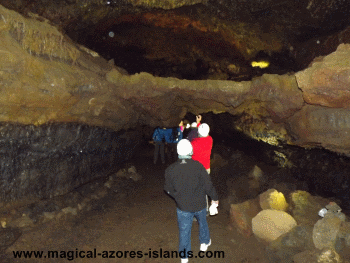| Back to Back Issues Page |
 |
|
Magical Azores Islands, Issue #022. Azores Caves August 26, 2012 |
Are you aware of the many caves and lava tubes that can be found throughout the Azores islands? I have some personal experiences and have collected some information that will be of benefit to you if you are interested in this. First, I wanted to comment on hurricane Gordon which has reached the Azores this past week. In my experience, a hurricane is a fairly rare occurrence in the islands. Hurricane Gordon did reach the Azores Islands and did cause some damage. Thankfully the damage reported is mostly minor. Broken windows, damaged roofs, and some washed out roads. But nothing too severe and no loss of life. Lava Tubes and Caves
There are over 270 known caves in the Azores, largely due to the lava tubes and lava pits formed during volcanic eruptions. But also due to very active seismic activity owing to the islands being located at the meeting point of three major tectonic plates (African, Eurasian, and North American). I have been in two of the four best known caves and really want to go to a third. The two that I have visited are in Sao Miguel and Terceira, the third that I wish to see is in Graciosa. Most Notable CavesGruta do Carvao, Sao Miguel - a lava tube in the western portion of Ponta Delgada. The lava tube is currently known as 1800 meters, but historical accounts suggest it may be as long as 5000 meters. The portion of the cave that is open for visitation has many interesting features including lava benches, lava balls, lava stalactites, lava stalagmites and various colours. It was interesting to see roots hanging through the roof of the cave from vegetation on the ground above. Another interesting feature is the vegetation that grows in the cave, even though there is no natural light! Algar do Carvao, Terceira - of the two caves I have visited, this is my favourite. It is actually a lava pit with a big opening in the roof. There is a lot to see in this cave, from the abundant vegetation near the big opening in the roof, to a significant number of stalagmites and stalactites, and 80 metres down into the cave is a lake. The walls and areas of the roof have quite a variety of colours and textures as well. I invite you to see some pictures I took at: Algar do Carvao. Gruta das Torres, Pico a lava tube in Madalena, Pico. At 5150 metres, this is the longest known lava tube in the Azores. Much like Gruta do Carvao in Sao Miguel, there are lava balls, lava stalactites, lava stalagmites and lava benches. Do Volcanic Eruptions Happen Often?Since the islands were settled in the 15th century, there have been 26 eruptions, 14 of which were under water. The last one was in Capelinhos, Faial, in 1958. I do recommend visiting Capelinhos. Have any Questions About the Azores?Chances are others have the same question! Please ask any questions you might have at: Magical Azores Islands Comments and Questions. Of course, you are also welcome to reply to this email as well!Thanks again for your subscription to the Magical Azores Islands e-zine. It is a pleasure to share some of my favourite spots and experiences with you. And I enjoy hearing back from you. So please feel free to share your experiences and ask questions. See you again soon!
All the best,
PS Please Note: Facts noted above were verified with the use of the book "Cavidades Vulcanicas das Acores" (2008). More info at www.speleoazores.com |
| Back to Back Issues Page |
